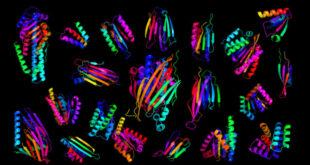A group of researchers at the Massachusetts Institute of Technology (MIT) has developed an injectable nanoparticle formulation of the inactivated polio vaccine that releases multiple pulses of stable antigen over time. This new vaccine could make it easier to immunize children in remote regions of Pakistan and other countries where polio is still found.
Single-injection polio vaccine could help eradicate the disease worldwide. Image credit: Tzeng et al.
There are no drugs against poliovirus, and in about 1% of cases, it enters the nervous system, where it can cause paralysis.
The first polio vaccine, also called the Salk vaccine, was developed in the 1950s. This vaccine consists of an inactivated version of the virus, which is usually given as a series of two to four injections, beginning at 2 months of age.
In 1961, an oral vaccine was developed, which offers some protection with only one dose but is more effective with two to three doses.
The oral vaccine, which consists of a virus that has reduced virulence but is still viable, has been phased out in most countries because in very rare cases, it can mutate to a virulent form and cause infection. It is still used in some developing countries, however, because it is easier to administer the drops than to reach children for multiple injections of the Salk vaccine.
For polio eradication efforts to succeed, the oral vaccine must be completely phased out, to eliminate the chance of the virus reactivating in an immunized person.
Several years ago, MIT Professor Robert Langer and colleagues set out to develop an injectable vaccine that could be given just once but carry multiple doses.
“The goal is to ensure that everyone globally is immunized. Children in some of these hard-to-reach developing world locations tend to not get the full series of shots necessary for protection,” said team member Dr. Ana Jaklenec, a scientist at MIT’s Koch Institute for Integrative Cancer Research.
To create a single-injection vaccine, the researchers encapsulated the inactivated polio vaccine in a biodegradable polymer known as PLGA. This polymer can be designed to degrade after a certain period of time, allowing the scientists to control when the vaccine is released.
“There’s always a little bit of vaccine that’s left on the surface or very close to the surface of the particle, and as soon as we put it in the body, whatever is at the surface can just diffuse away. That’s the initial burst,” said team member Dr. Stephany Tzeng, a former MIT postdoc who is now a research associate at Johns Hopkins University School of Medicine.
“Then the particles sit at the injection site and over time, as the polymer degrades, they release the vaccine in bursts at defined time points, based on the degradation rate of the polymer.”
In the new study, the team designed particles that would deliver an initial burst at the time of injection, followed by a second release about 25 days later.
The researchers injected the particles into rats, then sent blood samples from the immunized rats to the Centers for Disease Control for testing.
Those studies revealed that the blood samples from rats immunized with the single-injection particle vaccine had an antibody response against poliovirus just as strong as, or stronger than, antibodies from rats that received two injections of Salk polio vaccine.
“To deliver more than two doses, we could design particles that release vaccine at injection and one month later, and mix them with particles that release at injection and two months later, resulting in three overall doses, each a month apart,” the scientists said.
“The polymers that we used in the vaccines are already FDA-approved for use in humans, so we hope to soon be able to test the vaccines in clinical trials.”
The study was published online this week in the Proceedings of the National Academy of Sciences.
_____
Stephany Y. Tzeng et al. Stabilized single-injection inactivated polio vaccine elicits a strong neutralizing immune response. PNAS, published online May 21 ,2018; doi: 10.1073/pnas.1720970115
 #Bizwhiznetwork.com Innovation ΛI |Technology News
#Bizwhiznetwork.com Innovation ΛI |Technology News




